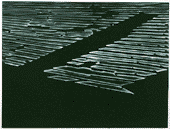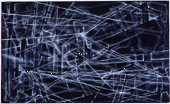
Louise Forthun, Federation
Square,
oil on linen, 137.0 x 183.0 cm, 1996
|
In her most recent
exhibition at Tolarno Gallery, Forthun uses the same
technique to construct 'a building site for the eyes'.
Placing strenuous demands on the optic fibres, Forthun's
paintings are optically vertigenous, although the affect
must be overcome while viewing them. While they
handsomely reward the 'long look', the power of her work
draws partly from the contrast in scale of operation
between the collective institutions she aims to depict
and the self-sufficient means which she chooses to do so.
Of late, the primitive nature of her technique has
become even more obvious with the lingering evidence of
masking tape used to hold her stencils steady on the
canvas. Similar uses of masking tape have become a
familiar feature of contemporary photography, evident in
the work of Mike and Doug Starn and ubiquitous in Bill
Henson's recent Lonsdale Street Power Station
installation. In the case of photography, tabs of masking
tape serve to fetishise the manual elements of
processing. This they can do in Forthun's paintings, but
their main business is to frame the several different
spatial perspectives present in one work. For instance, Blue
and Jagged contains what seems at first an infinite
array of facades until the eye can fix on the odd tab,
providing a stable point of view from which to extricate
the multiple perspectives.
|
 Louise Forthan, Cold,
oil on linen,
122.0 x 203.0 cm, 1996
|
The Gold and Fiery One
is a particularly intense work that saturates what
appears to be a factory scene with an almost solarised
yellow. In choosing such naive titles and intense
colours, Forthun seems to assert a defiant familiarity
towards otherwise grand structures. In this context, the
tab is a kind of thumbprint left as incidental evidence
of artistic intention. While in photography, masking tape
signifies darkroom processes, Forthun's painting alludes
more strongly to the digital practices that have
superseded them. As a screen technique, stencilling has
become ubiquitous in digital graphics: masking layers (or
alpha channels) enable images to be interleaved and
shadowed. Feathering these masks is a routine procedure
in the manufacture of drop shadows and frosted outlines. |